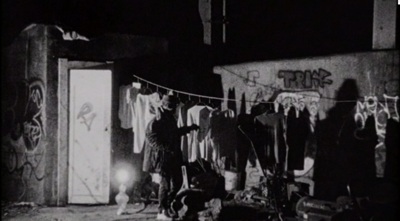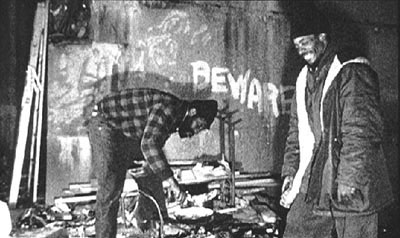I've been wracking my brain for last little while trying to come up with some kind of solution to my architectural problems, but I just haven't been having a whole lot of luck until now. I was told to go back and examine my machine a little more, and I did. I thought I had examined it enough, and that I had already come up with a solid idea, but it just wasn't working out, so I had to take a bit of a harder look.
So, look harder I did, and what do you know? I found out some interesting stuff.
What does it do?
The machine basically listens to info(sound) from a remote location and then relays that information to an observer at a central, hidden location. The user, in the case of the final build, was able to see the information as it came in, in order to expand his or her perception of the area.
What are its unique attributes?
One of the things I built into it, which was somewhat frowned upon, and certainly not explained very well, was the ability to pick the machine up and move it to another locale and instantly be able to see what was happening there. This is why the machine was on a small box, rather than on a wall or in some other kind of more permanent fixture.
The transmitters can also receive different kinds of data, so the idea that only sound can be broadcast isn't necessarily true, meaning that I could narrow down the info being recieved by the end user. The transmitters are also very mobile, and could be placed within a room, within a building, or go even further away to monitor different regions within a city, or different buildings within a block.
What are its problems?
As I discussed before, the data collected at the time was very general. I was going for mysterious in my own head, but when you strive for that, sometimes you just wash out all the interesting bits, which one could say I was guilty of doing.
The projection on the project was also limited in a way. Sure, the machine could monitor a very large area, and in that regard, it projected a long way out, but the information was kept to a single room, and the info received was kind of esoteric. You had to be in the know to actually realize what the machine was telling you. This limited my applications for the project, and I believe was why I was stuck.
Now, I've been doing a bit of research and thinking about what kind of problem I'd like to address in my architectural intervention at Point Douglas. One of the things that I knew about the area is that there is a fairly large concentration of homeless people who had resorted to staying in abandoned train cars near the river. This is a sad fact, to be sure, and it was something I wanted to address.
When I was in Chicago this August, I bought a magazine in the IIT bookstore, and inside there was a project done by a designer from San Francisco. What this designer had done was create a cardboard homeless shelter that was inspired by origami, so that a homeless person could fold it up and move around when they wanted to. It gave them a dry place to sleep as well as the ability to be mobile. This might not jive too much with my research so far, but what she did after she designed these shelters was include instructions on how to build a $35 radio transceiver, which would allow the homeless people to communicate with each other wirelessly. I think this idea is really interesting, because it allows even the most marginalized people to communicate and meet with each other when they otherwise wouldn't be able to.
This is a fine idea for San Francisco, but I have my reservations about cardboard shelters in the dead of Winnipeg Winter, and I wanted to look at other solutions. I can't remember the designer's name, unfortunately, since I can't find the magazine anymore, but I was able to find some other similar ideas.
http://www.indexaward.dk/2007/default.asp?id=706&show=nomination&nominationid=160&playmovie=wmvThis is a similar idea to the one in San Francisco, but this one is intended for disaster relief in Japan, and is actually made of paper.
My idea was to create a new kind of Winnipeg-friendly shelter using easily found materials and then create a similar type of radio transceiver. Instead of just existing on one band and working like a walkie-talkie, these transmitters could send sound to a central radio receiver, which would then rebroadcast all of those different channels out to the rest of the point. It would basically be a chat room for the homeless, where they could inform each other about where they are and the conditions in different spots. I think it could finally make my design a useful thing, as well as allow it to project even further, both in terms of receiving and transmitting data.
 It also uses wind energy, but it uses the sun's rays to heat it as well, using a more passive approach to heating and cooling. Each Earthship has its own water treatment facility, which uses plants to process grey water and black water, and the whole thing is supposedly self-sustaining. This is really interesting, but all of the ones I've seen thus far are situated in a desert climate, so some serious modifications would be necessary.
It also uses wind energy, but it uses the sun's rays to heat it as well, using a more passive approach to heating and cooling. Each Earthship has its own water treatment facility, which uses plants to process grey water and black water, and the whole thing is supposedly self-sustaining. This is really interesting, but all of the ones I've seen thus far are situated in a desert climate, so some serious modifications would be necessary. This is the one I found on instructables, and it can run using only a small candle underneath it, but there are other that can just by putting them on top of a cup of coffee or even just on your hand. That's a pretty interesting possibility, I think, and it's something I'd like to build and test out.
This is the one I found on instructables, and it can run using only a small candle underneath it, but there are other that can just by putting them on top of a cup of coffee or even just on your hand. That's a pretty interesting possibility, I think, and it's something I'd like to build and test out.


























